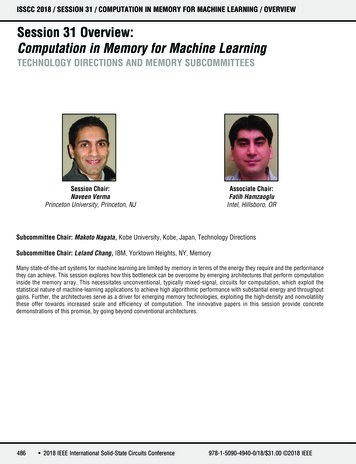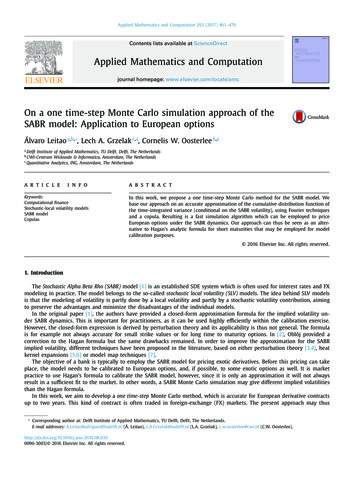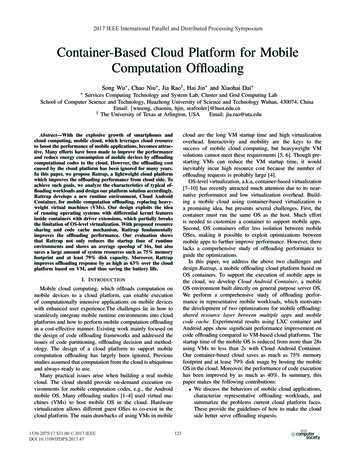
Transcription
ISSCC 2018 / SESSION 31 / COMPUTATION IN MEMORY FOR MACHINE LEARNING / OVERVIEWSession 31 Overview:Computation in Memory for Machine LearningTECHNOLOGY DIRECTIONS AND MEMORY SUBCOMMITTEESSession Chair:Naveen VermaPrinceton University, Princeton, NJAssociate Chair:Fatih HamzaogluIntel, Hillsboro, ORSubcommittee Chair: Makoto Nagata, Kobe University, Kobe, Japan, Technology DirectionsSubcommittee Chair: Leland Chang, IBM, Yorktown Heights, NY, MemoryMany state-of-the-art systems for machine learning are limited by memory in terms of the energy they require and the performancethey can achieve. This session explores how this bottleneck can be overcome by emerging architectures that perform computationinside the memory array. This necessitates unconventional, typically mixed-signal, circuits for computation, which exploit thestatistical nature of machine-learning applications to achieve high algorithmic performance with substantial energy and throughputgains. Further, the architectures serve as a driver for emerging memory technologies, exploiting the high-density and nonvolatilitythese offer towards increased scale and efficiency of computation. The innovative papers in this session provide concretedemonstrations of this promise, by going beyond conventional architectures.486 2018 IEEE International Solid-State Circuits Conference978-1-5090-4940-0/18/ 31.00 2018 IEEE
ISSCC 2018 / February 14, 2018 / 3:15 PM3:15 PM31.1 Conv-RAM: An Energy-Efficient SRAM with Embedded Convolution Computation for Low-Power CNNBased Machine Learning ApplicationsA. Biswas, Massachusetts Institute of Technology, Cambridge, MAIn Paper 31.1, MIT describes a compute-in-memory structure by performing multiplication between anactivation and 1-b weight on a bit line, and accumulation through analog-to-digital conversion of chargeacross bit lines. Mapping two convolutional layers to the accelerator, an accuracy of 99% is achieved ona subset of the MNIST dataset, at an energy efficiency of 28.1TOPS/W.3:45 PM31.2 A 42pJ/Decision 3.12TOPS/W Robust In-Memory Machine Learning Classifier with On-Chip TrainingS. K. Gonugondla, University of Illinois, Urbana-Champaign, ILIn Paper 31.2, UIUC describes a compute-in-memory architecture that simultaneously accesses multipleweights in memory to perform 8b multiplication on the bit lines, and introduces on-chip training, viastochastic gradient decent, to mitigate non-idealities in mixed-signal compute. An accuracy of 96% isachieved on the MIT-CBCL dataset, at an energy efficiency of 3.125TOPS/W4:15 PM31.3 Brain-Inspired Computing Exploiting Carbon Nanotube FETs and Resistive RAM: HyperdimensionalComputing Case StudyT. F. Wu, Stanford University, Stanford, CAIn Paper 31.3, Stanford/UCB/MIT demonstrate a brain-inspired hyperdimensional (HD) computingnanosystem to recognize languages and sentences from minimal training data. The paper uses 3Dintegration of CNTFETs and RRAM cells, and measurements show that 21 European languages can beclassified with 98% accuracy from 20,000 sentences.4:45 PM31.4 A 65nm 1Mb Nonvolatile Computing-in-Memory ReRAM Macro with Sub-16ns Multiply-andAccumulate for Binary DNN AI Edge ProcessorsW-H. Chen, National Tsing Hua University, Hsinchu, TaiwanIn Paper 31.4, National Tsing-Hua University implements multiply-and-accumulate operations using a1Mb RRAM array for a Binary DNN in edge processors. The paper proposes an offset-current-suppressingsense amp and input-aware, dynamic-reference current generation to overcome sense-margin challenges.Silicon measurements show successful operation with sub-16ns access time.5:00 PM31.5 A 65nm 4Kb Algorithm-Dependent Computing-in-Memory SRAM Unit-Macro with 2.3ns and55.8TOPS/W Fully Parallel Product-Sum Operation for Binary DNN Edge ProcessorsW-S. Khwa, National Tsing Hua University, Hsinchu, Taiwan and TSMC, Hsinchu, TaiwanIn Paper 31.5, National Tsing-Hua University demonstrates multiply-and-accumulate operations using a4kb SRAM for fully-connected neural networks in edge processors. The paper overcomes the challengesof excessive current, sense-amplifier offset, and sensing Vref optimization, arising due to simultaneousactivation of multiple word lines. Sub-3ns access speed is achieved with simulated 97.5% MNISTaccuracy.DIGEST OF TECHNICAL PAPERS 48731
ISSCC 2018 / SESSION 31 / COMPUTATION IN MEMORY FOR MACHINE LEARNING / 31.131.1Conv-RAM: An Energy-Efficient SRAM with EmbeddedConvolution Computation for Low-Power CNN-BasedMachine Learning ApplicationsAvishek Biswas, Anantha P. Chandrakasancharge-sharing is used to integrate the lower of the 2 voltage rails with a referencelocal column that replicates the local bit-line capacitance. This process continuesuntil the voltage of the rail being integrated exceeds the other one, at which pointthe SA output flips. This signals conversion completion and no further SA ENpulses are generated for the SA. Figure 31.1.4 shows the waveforms for a typicaloperation cycle. To reduce the effect of SA offset on YOUT value, a multiplexer isused at the input of the SA to flip the inputs on alternate cycles.Massachusetts Institute of Technology, Cambridge, MAConvolutional neural networks (CNN) provide state-of-the-art results in a widevariety of machine learning (ML) applications, ranging from image classificationto speech recognition. However, they are very computationally intensive andrequire huge amounts of storage. Recent work strived towards reducing the sizeof the CNNs: [1] proposes a binary-weight-network (BWN), where the filterweights (wi’s) are 1 (with a common scaling factor per filter: α ). This leads toa significant reduction in the amount of storage required for the wi’s, making itpossible to store them entirely on-chip. However, in a conventional all-digitalimplementation [2, 3], reading the wi’s and the partial sums from the embeddedSRAMs require a lot of data movement per computation, which is energy-hungry.To reduce data-movement, and associated energy, we present an SRAMembedded convolution architecture (Fig. 31.1.1), which does not require readingthe wi’s explicitly from the memory. Prior work on embedded ML classifiers havefocused on 1b outputs [4] or a small number of output classes [5], both of whichare not sufficient for CNNs. This work uses 7b inputs/outputs, which is sufficientto maintain good accuracy for most of the popular CNNs [1]. The convolutionoperation is implemented as voltage averaging (Fig. 31.1.1), since the wi’s arebinary, while the averaging factor (1/N) implements the weight-coefficient α (witha new scaling factor, M, implemented off-chip).Figure 31.1.2 shows the overall architecture of the 256 64 conv-SRAM (CSRAM)array. It is divided into 16 local arrays, each with 16 rows to reduce the areaoverhead of the ADCs and the local analog multiply-and-average (MAVa) circuits.Each local array stores the binary weights (wi’s) in the 10T bit-cells (logic-0 for 1 and logic-1 for -1) for each individual 3D filter in a conv-layer. Hence, eachlocal array has a dedicated ADC to compute its partial convolution output (YOUT).The input-feature-map values (XIN) are fed into column-wise DACs (GBL DAC),which pre-charge the global read bit-lines (GRBL) and the local bit-lines (LBL) toan analog voltage (Va) that is proportional to the digital XIN code. The GRBLs areshared by all of the local arrays, since in CNNs each input is shared/processed inparallel by multiple filters. Figure 31.1.3 shows the schematic of the proposedGBL DAC circuit. It consists of a cascoded PMOS constant current source. TheGRBL is charged with this current for a duration tON, which is directly proportionalto the XIN code. For better tON vs XIN linearity there should only be one ON pulsefor every code to avoid multiple charging phases. This is impossible to generateusing signals with binary-weighted pulse-widths. Hence, we propose animplementation where the 3 MSBs of XIN are used to select (using TD56) the ONpulse-width for the first-half of charging (TD56 is high) and the 3 LSBs for thesecond-half (TD56 is low). An 8:1 mux with 8 timing signals is shared during bothphases to reduce the area overhead and the signal routing. As such, it is possibleto generate a single ON pulse for each XIN code, as shown for codes 63 and 24 inFig. 31.1.3. This DAC architecture has better mismatch and linearity than thebinary-weighted PMOS charging DACs [4], since the same PMOS stack is usedto charge GRBL for all input codes. Furthermore, the pulse-widths of the timingsignals typically have less variation compared to those arising from PMOS Vtmismatch.After the DAC pre-charge phase, the wi’s in a local array are evaluated locally byturning on a RWL, as shown in Fig. 31.1.4. One of the local bit-lines (LBLF orLBLT) will be discharged to ground depending on the stored wi (0 or 1). This isdone in parallel for all 16 local arrays. Next, the RWL’s are turned off and theappropriate local bit-lines are shorted together horizontally to evaluate the averagevia the local MAVa circuit. MAVa passes the voltages of the LBLT and LBLF to thepositive (Vp-AVG) and negative (Vn-AVG) voltage rails, depending on the sign of theinput XIN (ENP is ON for XIN 0, ENN is ON for XIN 0). The difference between Vp-AVGand Vn-AVG is fed to a charge-sharing based ADC (CSH ADC) to get the digital valueof the computation (YOUT). Algorithm simulations (Fig. 31.1.1) show that YOUT hasa peak distribution around 0 and is typically limited to 7, for a full-scale input of 31. Hence, a serial integrating ADC architecture is more applicable than otherarea-intensive (e.g. SAR) or more power-hungry (e.g. flash) ADCs. A PMOS-inputsense-amplifier (SA) is used to compare Vp-AVG and Vn-AVG, and its output is fed tothe ADC logic. The first comparison determines the sign of YOUT, then capacitive488 2018 IEEE International Solid-State Circuits ConferenceThe 256 64 CSRAM array is implemented in a 65nm LP-CMOS process. Figure31.1.5 shows the measured GBL DAC results, which is used in its 5b mode bysetting the LSB of XIN to 0. To estimate the DAC analog output voltage (Va), VGRBLfor the 64 columns are compared to an external Vref by column-wise SA’s, usedin the SRAM’s global read circuit. For each XIN, the Vref at which more than 50%of the SA outputs flip is chosen as an average estimate of Va. An initial one-timecalibration is needed to set Va 1V for XIN 31 (max. input code). As seen inFig. 31.1.5, there is good linearity in the DAC transfer function with DNL 1LSB.Figure 31.1.5 also shows the overall system transfer function, consisting of theGBL DAC, MAVa and CSH ADC circuits. For this experiment, same code isprovided to all XIN’s, all wi’s have the same value, and the YOUT outputs areobserved. The measurement results show good linearity in the overall transferfunction and low variation in the YOUT values: mainly because variation in BLcapacitance (used for averaging and CSH ADC) is much lower than transistor Vtvariation. SA offset cancelation further helps to reduce YOUT variation. It can bealso seen from Fig. 31.1.5 that the energy/ADC scales linearly with the outputcode, which is expected for an integrating ADC topology.To demonstrate the functionality for a real CNN architecture, the MNIST handwritten digit recognition dataset is used with the LeNet-5 CNN. 100 test imagesare run through the 2 convolutional and 2 fully-connected layers (implementedby the CSRAM array). We achieve a classification error rate of 1% after the first2 convolutional layers and 4% after all the 4 layers, which demonstrates the abilityof the CSRAM architecture to compute convolutions. The distribution of YOUT inFig. 31.1.6 for the first 2 computation-intensive convolutional layers (C1, C3)show that both layers have a mean of 1LSB, justifying the use of a serial ADCtopology. Figure 31.1.6 also shows the overall computational energy annotatedwith the different components. Layers C1 and C3 consume 4.23pJ and 3.56pJper convolution, computing 25 and 50 MAV operations in each cycle respectively.Layer C3 achieves the best energy efficiency of 28.1TOPS/W compared to 11.8for layer C1, since C1 uses only 6 of the 16 local arrays. Compared to prior digitalaccelerator implementations for MNIST, we achieve a 16 improvement inenergy-efficiency, and a 60 higher FOM (energy-efficiency throughput/SRAMsize) due to the massively parallel in-memory analog computations. Thisdemonstrates that the proposed SRAM-embedded architecture is capable ofhighly energy-efficient convolution computations that could enable low-powerubiquitous ML applications for a smart Internet-of-Everything.Acknowledgements:This project was funded by Intel Corporation. The authors thank Vivienne Sze andHae-Seung Lee for their helpful technical discussions.References:[1] M. Rastegari, et al., “XNOR-Net: ImageNet Classification Using BinaryConvolutional Neural Networks”, arXiv:1603.05279, 2016,https://arxiv.org/abs/1603.05279.[2] J. Sim, et al., “A 1.42TOPS/W Deep Convolutional Neural Network RecognitionProcessor for Intelligent IoE Systems”, ISSCC, pp. 264-265, 2016.[3] B. Moons, et al., “A 0.3–2.6 TOPS/W Precision-Scalable Processor for RealTime Large-Scale ConvNets”, IEEE Symp. VLSI Circuits, 2016.[4] J. Zhang, et al., “A Machine-Learning Classifier Implemented in a Standard6T SRAM Array”, IEEE Symp. VLSI Circuits, 2016.[5] M. Kang, et al, “A 481pJ/decision 3.4M decision/s Multifunctional Deep Inmemory Inference Processor using Standard 6T SRAM Array”, arXiv:1610.07501,2016, /18/ 31.00 2018 IEEE
ISSCC 2018 / February 14, 2018 / 3:15 PMFigure 31.1.1: Concept of embedded convolution computation, performed byaveraging in SRAM, for binary-weight convolutional neural networks.Figure 31.1.2: Overall architecture of the Convolution-SRAM (CSRAM) showinglocal arrays, column-wise DACs and row-wise ADCs to implement convolutionas weighted averaging.Figure 31.1.3: Schematic and timing diagram for the column-wise G
across bit lines. Mapping two convolutional layers to the accelerator, an accuracy of 99% is achieved on a subset of the MNIST dataset, at an energy efficiency of 28.1TOPS/W. 3:45 PM 31.2 A 42pJ/Decision 3.12TOPS/W Robust In-Memory Machine Learning Classifier with On-Chip Training S. K. Gonugondla, University of Illinois, Urbana-Champaign, IL In Paper 31.2, UIUC describes a compute-in-memory .











